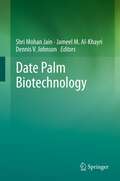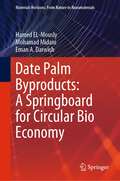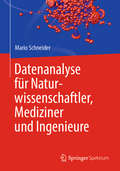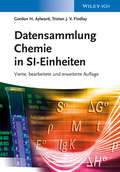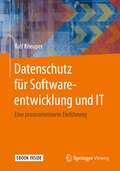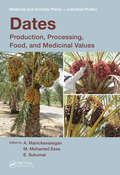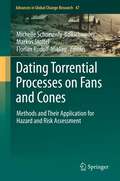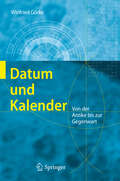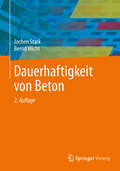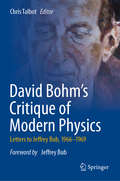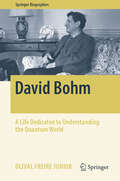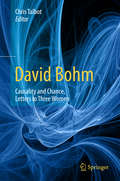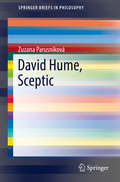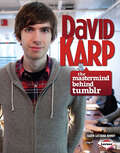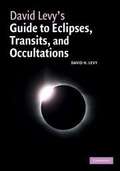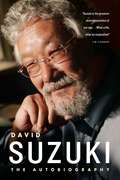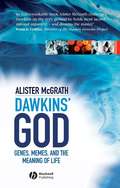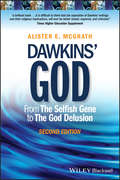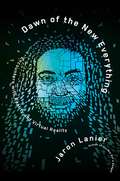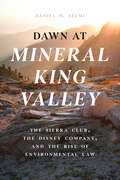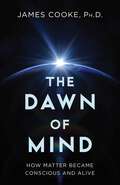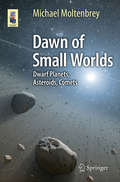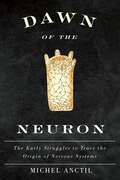- Table View
- List View
Date Palm Biotechnology: Tissue Culture Applications (Methods in Molecular Biology #1637)
by Shri Mohan Jain Jameel M. Al-Khayri Dennis V. JohnsonThis important reference book is the first comprehensive resource worldwide that reflects research achievements in date palm biotechnology, documenting research events during the last four decades, current status, and future outlook. This book is essential for researchers, policy makers, and commercial entrepreneurs concerned with date palm. The book is invaluable for date palm biotechnology students and specialists. This monument is written by an international team of experienced researchers from both academia and industry. It consists of five sections covering all aspects of date palm biotechnology including A) Micropropagation, B) Somaclonal Variation, Mutation and Selection, C) Germplasm Biodiversity and Conservation, D) Genetics and Genetic Improvement, and E) Metabolites and Industrial Biotechnology. The book brings together the principles and practices of contemporary date palm biotechnology. Each chapter contains background knowledge related to the topic, followed by a comprehensive literature review of research methodology and results including the authors own experience including illustrative tables and photographs.
Date Palm Byproducts: A Springboard for Circular Bio Economy (Materials Horizons: From Nature to Nanomaterials)
by Mohamad Midani Hamed EL-Mously Eman A. DarwishThis comprehensive book presents an alternative fresh look at date palm byproducts as a springboard for the future circular bio economy. The book shows and exemplifies how these sustainable biomaterials can be the base for a wide spectrum of products and uses. Examples of these numerous products and uses are demonstrated and categorized into five principal uses: i) pharmaceutical, cosmetics and natural wax ,ii) textiles and composites, cellulose and cellulose derivatives, iii)timber and wood substitutes, architecture insulation and building materials, iv) organic fertilizer, compost and soil amendment and water treatment purposes, v) natural fodder and silage , green fuels and bioenergy.
Daten- und Identitätsschutz in Cloud Computing, E-Government und E-Commerce
by Jörg Schwenk Georg BorgesFür neue und künftige Geschäftsfelder von E-Commerce und E-Government stellen der Datenschutz und der Identitätsschutz wichtige Herausforderungen dar. Renommierte Autoren aus Wissenschaft und Praxis widmen sich in dem Band aktuellen Problemen des Daten- und Identitätsschutzes aus rechtlicher und technischer Perspektive. Sie analysieren aktuelle Problemfälle aus der Praxis und bieten Handlungsempfehlungen an. Das Werk richtet sich an Juristen und technisch Verantwortliche in Behörden und Unternehmen sowie an Rechtsanwälte und Wissenschaftler.
Datenanalyse für Naturwissenschaftler, Mediziner und Ingenieure
by Mario SchneiderDieses Buch bietet Ihnen eine verständlich vermittelte Ausgangsbasis für die praktische Anwendung datenanalytischer Methoden, die sinnvolle Interpretation von Daten und die Ableitung von Informationen. Dabei setzt dieses Buch anstelle langer mathematischer Herleitungen und Beweise auf konkrete Beispiele, die jeweils Schritt für Schritt nachvollzogen werden. Die ausgewählten Beispieldaten werden mit Hilfe von Excel analysiert und das Erlernte kann anhand von Übungsaufgaben überprüft werden. Zusätzlich können Sie in Onlinevideos die Rechenschritte nachvollziehen und parallel in Excel mitrechnen. Damit liefert Ihnen dieses Buch nicht nur das für die wissenschaftliche Praxis notwendige Basiswissen der Datenanalyse, sondern bietet gleichermaßen das Fundament für einen souveränen Umgang mit den entsprechenden Instrumenten. Dieses Buch unterstützt somit Naturwissenschaftler, Mediziner und Ingenieure in Studium und Praxis und bietet einen leichten Einstieg in die statistische Datenanalyse und ihre Anwendung in Excel.
Datensammlung Chemie in SI-Einheiten
by Gordon H. Aylward Tristan J. FindlayMan möchte vor dem Experiment die Wärmeentwicklung einer Reaktion abschätzen, eine neue Syntheseidee auf Plausibilität prüfen oder die Kenngrößen einer neuen Substanz in Beziehung zu bereits bekannten setzen - dies bedeutet meist für jeden Wissenschaftler einen zeitaufwendigen Besuch in der Bibliothek. Denn wie oft basieren die Daten auf unterschiedlichen Bezugssystemen, sind in landestypischen Nicht-SI-Einheiten angegeben und erfordern mehrmaliges Umrechnen. Diese kompakte Datensammlung enthält genau die Werte, die jeder Chemiker immer wieder benötigt. Alle Daten stehen untereinander in Beziehung und sind aufeinander abgestimmt. Für alle Größen werden die SI-Einheiten verwendet, doch sind natürlich die entsprechenden Umrechnungsfaktoren für Nicht-SI-Einheiten angegeben. Dass diese Neuauflage auf dem neuesten Stand ist und Sicherheitshinweise enthält, versteht sich von selbst.
Datenschutz für Softwareentwicklung und IT: Eine praxisorientierte Einführung
by Ralf KneuperDieses Buch beschreibt das Thema Datenschutz aus der Sicht von Softwareentwicklung und IT. Die Verantwortlichen in diesen Bereichen gestalten die praktische Umsetzung des Datenschutzes zu erheblichen Teilen mit, benötigen dafür aber entsprechende Kenntnisse über die rechtlichen Rahmenbedingungen und Möglichkeiten zu deren Umsetzung. Der Fokus dieses Buchs liegt daher auf den Aspekten des Datenschutzes, die durch Softwareentwicklung stark beeinflusst werden, wie z.B. Privacy by Design, Privacy by Default, Datenminimierung, Umsetzung von Auskunftsrechten sowie Datenlöschung.
Dates: Production, Processing, Food, and Medicinal Values (Medicinal and Aromatic Plants - Industrial Profiles)
by M. Mohamed Essa A. Manickavasagan E. SukumarOf the many varieties of date palms, the species Phoenix dactylifera Linn. is cultivated extensively and traded and consumed worldwide. Dates: Production, Processing, Food, and Medicinal Values draws from a broad spectrum of contributors to present a comprehensive survey of this particular species. The book explores a range of essential facets of w
Dating Torrential Processes on Fans and Cones: Methods and Their Application for Hazard and Risk Assessment (Advances in Global Change Research #47)
by Florian Rudolf-Miklau Markus Stoffel Michelle Schneuwly-BollschweilerThis book provides a detailed overview on methods used for the dating of past torrential activity on fans and cones and fosters the discussion on the impact of past and potential future climate change on torrential processes. The book has a clear focus on the practical applications of these methods, complemented by case studies. The limits of each dating method in case of excessive natural and human interventions on fans and cones are shown.
Datum und Kalender: Von der Antike bis zur Gegenwart
by Winfried GörkeNach einer Einführung in das Kalenderwesen erläutert der Autor Alternativen zum gregorianischen Kalender. Er präsentiert verschiedene Kalendersysteme wie den europäischen, den japanischen, chinesischen und den jüdischen Kalender und erläutert anhand der Oster-Berechnung die Methoden der Informatik, die für die Festlegung kalenderabhängiger Festtage von Bedeutung sind. Darüber hinaus stellt er eine Reihe von Vorschlägen zur Verbesserung von Kalendern vor.
Dauerhaftigkeit von Beton: Der Baustoff Als Werkstoff (Baupraxis Ser.)
by Jochen Stark Bernd WichtDieses Buch befasst sich mit den Gr#65533;#65533;en und Einfl#65533;ssen, die f#65533;r die Dauerhaftigkeit des Baustoffs Beton von Bedeutung sind. Zahlreiche Bilder er#65533;ffnen praxisorientierte Einblicke in die werkstoffkundlichen Vorg#65533;nge. Kenngr#65533;#65533;en und Einflussfaktoren auf die Dauerhaftigkeit von Beton - Zement - Carbonatisierung - Sulfatangriff - sch#65533;digende Ettringitbildung im erh#65533;rteten Beton - S#65533;ureangriff - Einwirkung von Chloriden - Alkali-Kiesels#65533;ure-Reaktion - Frost- und Frosttausalz-Widerstand.
Daughters of Alchemy
by Meredith K. RayMeredith Ray shows that women were at the vanguard of empirical culture during the Scientific Revolution. They experimented with medicine and alchemy at home and in court, debated cosmological discoveries in salons and academies, and in their writings used their knowledge of natural philosophy to argue for women's intellectual equality to men.
David Bohm's Critique of Modern Physics: Letters to Jeffrey Bub, 1966-1969
by Chris TalbotIn the letters contained in this book, David Bohm argues that the dominant formal, mathematical approach in physics is seriously flawed. In the 1950s and 60s, Bohm took a direction unheard of for a professor of theoretical physics: while still researching in physics, working among others with Yakir Aharanov and later Jeffrey Bub, he also spent time studying “metaphysics”—such as Hegel’s dialectics and Indian panpsychism. 50 years on, questions raised about the direction and philosophical assumptions of theoretical physics show that Bohm’s arguments still have contemporary relevance.
David Bohm: A Life Dedicated to Understanding the Quantum World (Springer Biographies)
by Olival Freire JuniorThis authoritative biography addresses the life and work of the quantum physicist David Bohm. Although quantum physics is considered the soundest physical theory, its strange and paradoxical features have challenged - and continue to challenge - even the brightest thinkers. David Bohm dedicated his entire life to enhancing our understanding of quantum mysteries, in particular quantum nonlocality. His work took place at the height of the cultural/political upheaval in the 1950's, which led him to become the most notable American scientist to seek exile in the last century. The story of his life is as fascinating as his ideas on the quantum world are appealing.
David Bohm: Causality and Chance, Letters to Three Women
by Chris TalbotThe letters transcribed in this book were written by physicist David Bohm to three close female acquaintances in the period 1950 to 1956. They provide a background to his causal interpretation of quantum mechanics and the Marxist philosophy that inspired his scientific work in quantum theory, probability and statistical mechanics. In his letters, Bohm reveals the ideas that led to his ground breaking book Causality and Chance in Modern Physics. The political arguments as well as the acute personal problems contained in these letters help to give a rounded, human picture of this leading scientist and twentieth century thinker.
David Hume, Sceptic (SpringerBriefs in Philosophy)
by Zuzana ParusnikováThis book studies Hume’s scepticism and its roots, context, and role in the philosopher’s life. It relates how Hume wrote his philosophy in a time of tumult, as the millennia-old metaphysical tradition that placed humans and their cognitive abilities in an ontological framework collapsed and gave way to one that placed the autonomy of the individual in its center. It then discusses the birth of modernity that Descartes inaugurated and Kant completed with his Copernican revolution that moved philosophy from Being to the Self. It shows how modernity gave rise to a new kind of scepticism, involving doubt not just about the adequacy of our knowledge but about the very existence of a world independent of the self. The book then examines how Hume faced the sceptical implications and how his empiricism added yet another sceptical theme with the main question being how argument can legitimize key concepts of human understanding instinctively used in making sense of our perceptions. Placing it firmly in a historical context, the book shows how Hume was influenced by Pyrrhonian scepticism and how this becomes clear in Hume’s acceptance of the weakness of reason and in his emphasis on the practical role of philosophy. As the book argues, rather than serving as the foundation of science, in Hume’s hand, philosophy became a guide to a joyful, happy life, to a documentary of common life and to moderately educated, entertaining conversation. This way Hume stands in strong opposition to the (early) modern mainstream.
David Karp: The Mastermind behind Tumblr (Gateway Biographies Ser.)
by Karen Latchana KenneyWhat's more popular than Tumblr? This microblogging site has taken the Web by storm since its founding in 2007. Not much can top it when it comes to capturing its fans' imaginations, except for perhaps its creator, David Karp. Karp developed Tumblr after he tried to start a blog and found the process daunting. With most platforms, a blogger faces a huge, empty text box that begs to be filled with words. It was intimidating for a guy who'd never blogged before. Karp had the idea for tumblelogging—creating short blog posts—and built Tumblr as a platform. It lets users easily post both text and images, making Tumblr highly visual and expressive. Creating a different way to blog came naturally to Karp, who never does things by the book. At fifteen, he dropped out of school. At seventeen, he moved to Tokyo, holing up with a computer and fine-tuning his tech skills. He returned to the states to build a business—but to do that, he stretched the truth. He used a deep voice on the phone with potential clients so they wouldn't guess how young he was. He didn't tell anyone how little experience he had. Yet people could see he had a good thing going with Tumblr. The company quickly found support and grew into what it is today: a groundbreaking site for connection and creation. And as the mastermind behind it, Karp is sure to remain a figure to watch.
David Levy's Guide to Eclipses, Occultations, and Transits
by David H. Levy"In this simple guide, David Levy inspires readers to experience the wonder of eclipses and other transient astronomical events for themselves. Covering both solar and lunar eclipses, he gives step-by-step instructions on how to observe and photograph eclipses. As well as explaining the science behind eclipses, the book also gives their historical background, discussing how they were observed in the past and what we have learned from them. This personal account contains examples from the 77 eclipses the author has witnessed himself. The guide also includes chapters on occultations of stars and planets by the Moon and of asteroids by stars, and the transits of Mercury and Venus. Tables of future eclipses make this invaluable for anyone, from beginners to practised observers, wanting to learn more about these fascinating events"--
David Suzuki
by David SuzukiDavid Suzuki's autobiography limns a life dedicated to making the world a better place. The book expands on the early years covered in Metamorphosis and continues to the present, when, at age 70, Suzuki reflects on his entire life - and his hopes for the future. The book begins with his life-changing experience of racism interned in a World War II concentration camp, and goes on to discuss his teenage years, his college and postgraduate experiences in the U.S., and his career as a geneticist and then as the host of The Nature of Things. With characteristic candor and passion, he describes how he became a leading environmentalist, writer, and thinker; the establishment of the David Suzuki Foundation; his world travels and meetings with luminaries like Nelson Mandela and the Dalai Lama; and the abiding role of nature and family in his life. David Suzuki is an intimate and inspiring look at a modern-day visionary.
Dawkins' GOD
by Alister E. McgrathAlister E. McGrath is one of the world's leading theologians, with a doctorate in the sciences. Richard Dawkins is one of the bestselling popular science writers, with outspoken and controversial views on religion. This fascinating and provoking work is the first book-length response to Dawkins' ideas, and offers an ideal introduction to the topical issues of science and religion.Addresses fundamental questions about Dawkins' approach to science and religion: Is the gene actually selfish? Is the blind watchmaker a suitable analogy? Are there other ways of looking at things? Tackles Dawkins' hostile and controversial views on religion, and examines the religious implications of his scientific ideas, making for a fascinating and provoking debate Written in a very engaging and accessible style, ideal to those approaching scientific and religious issues for the first time Alister McGrath is uniquely qualified to write this book. He is one of the world's best known and most respected theologians, with a strong research background in molecular biophysics A superb book by one of the world's leading theologians, which will attract wide interest in the growing popular science market, similar to Susan Blackmore's The Meme Machine (1999).
Dawkins' God: From The Selfish Gene to The God Delusion
by Alister E. McGrathA fully updated new edition of a critically acclaimed examination of the theories and writings of Richard Dawkins by a world-renowned expert on the relation of science and religion Includes in-depth analysis of Dawkins’ landmark treatise The God Delusion (2006), as well as coverage of his later popular works The Magic of Reality (2011) and The Greatest Show on Earth (2011),and a new chapter on Dawkins as a popularizer of science Tackles Dawkins’ hostile and controversial views on religion, and examine the religious implications of his scientific ideas including a comprehensive investigation of the ‘selfish gene’ Written in an accessible and engaging style that will appeal to anyone interested in better understanding the interplay between science and religion
Dawn Of The New Everything: Encounters With Reality And Virtual Reality
by Jaron LanierBridging the gap between tech mania and the experience of being inside the human body, Dawn of the New Everything is a look at what it means to be human at a moment of unprecedented technological possibility. <p><p> Through a fascinating look back over his life in technology, Jaron Lanier, an interdisciplinary scientist and father of the term “virtual reality,” exposes VR’s ability to illuminate and amplify our understanding of our species, and gives readers a new perspective on how the brain and body connect to the world. An inventive blend of autobiography, science writing, philosophy and advice, this book tells the wild story of his personal and professional life as a scientist, from his childhood in the UFO territory of New Mexico, to the loss of his mother, the founding of the first start-up, and finally becoming a world-renowned technological guru. <p> Understanding virtual reality as being both a scientific and cultural adventure, Lanier demonstrates it to be a humanistic setting for technology. While his previous books offered a more critical view of social media and other manifestations of technology, in this book he argues that virtual reality can actually make our lives richer and fuller.
Dawn at Mineral King Valley: The Sierra Club, the Disney Company, and the Rise of Environmental Law
by Daniel P. SelmiThe story behind the historic Mineral King Valley case, which reveals how the Sierra Club battled Disney’s ski resort development and launched a new environmental era in America. In our current age of climate change–induced panic, it’s hard to imagine a time when private groups were not actively enforcing environmental protection laws in the courts. It wasn’t until 1972, however, that a David and Goliath–esque Supreme Court showdown involving the Sierra Club and Disney set a revolutionary legal precedent for the era of environmental activism we live in today. Set against the backdrop of the environmental movement that swept the country in the late 1960s and early 1970s, Dawn at Mineral King Valley tells the surprising story of how the US Forest Service, the Disney company, and the Sierra Club each struggled to adapt to the new, rapidly changing political landscape of environmental consciousness in postwar America. Proposed in 1965 and approved by the federal government in 1969, Disney’s vast development plan would have irreversibly altered the practically untouched Mineral King Valley, a magnificently beautiful alpine area in the Sierra Nevada mountains. At first, the plan met with unanimous approval from elected officials, government administrators, and the press—it seemed inevitable that this expanse of wild natural land would be radically changed and turned over to a private corporation. Then the scrappy Sierra Club forcefully pushed back with a lawsuit that ultimately propelled the modern environmental era by allowing interest groups to bring litigation against environmentally destructive projects. An expert on environmental law and appellate advocacy, Daniel P. Selmi uses his authoritative narrative voice to recount the complete history of this revolutionary legal battle and the ramifications that continue today, almost 50 years later.
Dawn of Mind: How Matter Became Conscious and Alive
by James CookeAlthough consciousness is at the very center of who we are, its exact nature continues to confound modern science. From where does consciousness originate? At our core, are we material bodies or immaterial conscious minds? Many assume that consciousness is a product of our complex brains, a product of evolution—and yet, there is no evolutionary reason that a mechanical function of the brain should allow us to enjoy the beauty of a sunrise or become intoxicated with the smell of rain on dry earth. If consciousness is not the product of sophisticated human brains, might the nonhuman living world be conscious? If so, where does that place us in relation to the rest of life on Earth—and what does this imply about our domination and plundering of the natural world for resources? Dr. James Cooke is no stranger to intricate and existential questions such as these, and he confronts them head-on in his compelling, inventive, revolutionary new book, The Dawn of Mind. Weaving together cutting-edge science and the contemplative insights that arise from mystical experience, as occurs with meditation and the emerging therapeutic paradigm of psychedelic medicine, Cooke radically redraws our understanding of what it truly means to be who we are.Though Cooke approaches the question of consciousness from a rigorous, scientific stance, his first foray into the study of consciousness was an intensely personal one. On a bus ride through Colchester, the ancient Roman capital of Britain, Cooke spontaneously felt himself feeling intensely and fully connected with the natural world around him; his sense of self fell away entirely. This transcendent moment inspired years of scientific study and the contemplative exploration of personal mystical experiences, leading Cooke to a stunning revelation: our sense of self is not an objective fact but an illusion, a survival technique we use to try and find order in a disorderly world. We each construct a boundary between ourselves and the natural world, constantly simulating what will happen around us in order to survive and navigate our surroundings. (Consider this: how long would you make it if you were crossing a busy street and only reacted to an oncoming car reflexively, once you felt its touch on your skin?) Unlike the self, however, consciousness is no such illusion, and is the product of the very same survival process – it is the simulation in which our sense of self appears. Of course, we aren&’t the only creatures who function in this way. According to Cooke, consciousness is not complex brain function that only we possess but a deeply embodied phenomenon, an essential feature of being a living thing. Sure, we aren&’t conscious in the same way as a tree or a worm, but as living things we are all conscious; just maybe, this notion of our dominion over all other life on earth was a ruse all along. Understanding consciousness in this way is not just some theoretical exercise. As climate change amplifies by the day, a growing chorus of voices insists that our fundamental disconnect from nature is at the root of our ecological crisis. Healing the divide between nature and consciousness may be the key to extricating ourselves from this dire predicament.
Dawn of Small Worlds: Dwarf Planets, Asteroids, Comets (Astronomers' Universe)
by Michael MoltenbreyThis book gives a detailed introduction to the thousands and thousands of smaller bodies in the solar system. Written for interested laymen, amateur astronomers and students it describes the nature and origin of asteroids, dwarf planets and comets, and gives detailed information about their role in the solar system. The author nicely reviews the history of small-world-exploration and describes past, current and future space craft missions studying small worlds, and presents their results. Readers will learn that small solar system worlds have a dramatically different nature and appearance than the planets. Even though research activity on small worlds has increased in the recent past many of their properties are still in the dark and need further research.
Dawn of the Neuron: The Early Struggles to Trace the Origin of Nervous Systems
by Michel AnctilIn science, sometimes it is best to keep things simple. <P><P>Initially discrediting the discovery of neurons in jellyfish, mid-nineteenth-century scientists grouped jellyfish, comb-jellies, hydra, and sea anemones together under one term - "coelenterates" - and deemed these animals too similar to plants to warrant a nervous system. In Dawn of the Neuron, Michel Anctil shows how Darwin's theory of evolution completely eradicated this idea and cleared the way for the modern study of the neuron. Once zoologists accepted the notion that varying levels of animal complexity could evolve, they began to use simple-structured creatures such as coelenterates and sponges to understand the building blocks of more complicated nervous systems. Dawn of the Neuron provides fascinating insights into the labours and lives of scientists who studied coelenterate nervous systems over several generations, and who approached the puzzling origin of the first nerve cells through the process outlined in evolutionary theory. Anctil also reveals how these scientists, who were willing to embrace improved and paradigm-changing scientific methods, still revealed their cultural backgrounds, their societal biases, and their attachments to schools of thought and academic traditions while presenting their ground-breaking work. Their attitudes toward the neuron doctrine - where neurons are individual, self-contained cells - proved decisive in the exploration of how neurons first emerged. Featuring photographs and historical sketches to illustrate this quest for knowledge, Dawn of the Neuron is a remarkably in-depth exploration of the link between Darwin's theory of evolution and pioneering studies and understandings of the first evolved nervous systems
